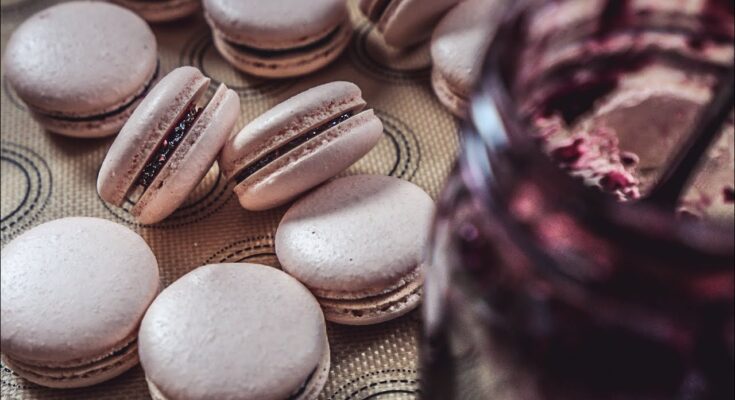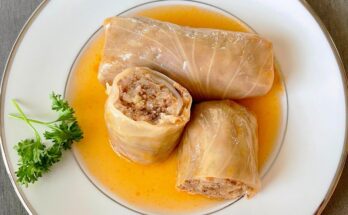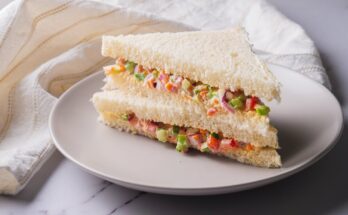Macarons Recipe: Macarons are delicate, colorful French confections known for their crisp outer shells and chewy interiors. Made with almond flour, egg whites, and sugar, these sweet treats are sandwiched together with a variety of fillings such as buttercream, ganache, or jam.
Originating in Italy and refined in France, macarons have become a worldwide symbol of elegance and craftsmanship. While notoriously challenging to perfect, mastering them is a rewarding journey for any baker.
Essential Ingredients for Macarons
Main Ingredients You’ll Need
To make macarons, you’ll need these key ingredients:
- Almond Flour: Provides the essential nutty flavor and texture. Choose finely ground, blanched almond flour for best results.
- Powdered Sugar: Sweetens and helps achieve a smooth shell.
- Egg Whites: The foundation for the meringue, which gives macarons their structure.
- Granulated Sugar: Stabilizes the meringue and creates shiny shells.
- Food Coloring & Flavorings: Use gel food coloring and extracts to customize your macarons.
Optional Ingredients and Alternatives
- Substitute almond flour with sunflower seed flour for a nut-free version.
- Add freeze-dried fruit powders for natural flavor enhancements.
Equipment Needed for Perfect Macarons
Precision is crucial when making macarons. Here’s what you’ll need:
- Mixing Bowls and Whisks: For preparing the batter.
- Sifter or Fine Mesh Strainer: To ensure smooth, lump-free dry ingredients.
- Piping Bags and Tips: For creating uniform circles.
- Silicone Baking Mats or Parchment Paper: Prevent sticking and promote even baking.
- Kitchen Scale: Ensures accuracy in measurements, which is vital for macarons.
- Oven Thermometer: Helps maintain consistent baking temperature.
Preparation Steps Before Baking
Preparing the Ingredients
- Sift the Dry Ingredients: Combine almond flour and powdered sugar, sifting multiple times to remove lumps.
- Age the Egg Whites: Let egg whites sit at room temperature for 24-48 hours to improve their stability.
Setting Up Your Workspace
- Clean the Equipment Thoroughly: Any grease or moisture can ruin your meringue.
- Preheat the Oven: Set it to the correct temperature (typically 300°F or 150°C) and ensure consistency with an oven thermometer.
Making the Macaron Batter
Whipping the Meringue
- Use a stand or hand mixer to beat egg whites until foamy.
- Gradually add granulated sugar, beating until stiff, glossy peaks form.
- Add food coloring or flavor extract, mixing gently to avoid deflating the meringue.
Folding the Almond Flour Mixture
- Incorporate the dry ingredients into the meringue in small batches.
- Use a folding technique: scrape around the bowl and fold through the center.
- Look for a “lava-like” consistency where the batter flows slowly but doesn’t lose shape.
Piping the Macarons
- Fit your piping bag with a round tip and fill it with the macaron batter.
- Pipe small circles (about 1.5 inches in diameter) onto a silicone mat or parchment paper.
- Tap the tray firmly against the counter to release air bubbles, then pop any visible bubbles with a toothpick.
Resting the Macarons
Resting is a critical step in the macaron-making process. Once piped, let the macarons sit at room temperature until a thin skin forms on the surface. This usually takes 20–60 minutes, depending on humidity. To check if they’re ready, gently touch the surface of a shell; it should feel dry and not stick to your finger. This step helps create the iconic smooth tops and prevents cracking during baking.
Baking the Macarons
- Preheat Your Oven: Ensure it’s properly preheated to 300°F (150°C). Use an oven thermometer for accuracy.
- Bake the Macarons: Place the tray in the middle rack and bake for 12–15 minutes. Rotate the tray halfway through for even baking.
- Check for Doneness: The macarons should have formed a “foot” (the ruffled edge) and release easily from the baking mat when gently lifted.
- Cool Completely: Allow the shells to cool on the baking sheet before attempting to remove them. This prevents sticking or breaking.
Making the Filling
The filling is where you can get creative! Here are three popular options:
Buttercream
- Cream 1 cup of softened butter with 2 cups of powdered sugar.
- Add 1–2 tablespoons of heavy cream or milk for a smoother consistency.
- Flavor with extracts (e.g., vanilla, almond, or lemon) or mix in fruit purees.
Ganache
- Heat 1/2 cup of heavy cream until steaming (but not boiling).
- Pour over 1 cup of finely chopped chocolate (dark, milk, or white).
- Stir until smooth and let cool to a pipeable consistency.
Jam or Fruit Preserves
- Use high-quality, thick jams to add fruity brightness to your macarons.
- Avoid overly runny fillings, as they can make the macarons soggy.
Assembling the Macarons
- Match shells of similar sizes to ensure uniform sandwiches.
- Pipe a small dollop of filling onto the flat side of one shell.
- Gently press a matching shell on top until the filling spreads to the edges. Avoid applying too much pressure, as the shells are delicate.
Storing and Maturing Macarons
Macarons taste best after maturing for 24–48 hours. During this time, the filling softens the interior of the shells, blending the flavors perfectly.
Storage Tips:
- Store assembled macarons in an airtight container in the fridge.
- Bring to room temperature before serving for optimal taste and texture.
- Macarons can be frozen for up to 3 months if stored in an airtight container with parchment paper between layers.
FAQs about Macarons Recipe
What are the key ingredients in a macaron recipe?
The essential ingredients for making macarons include almond flour, granulated sugar, powdered sugar, and egg whites. Some recipes may also call for food coloring and flavor extracts to enhance the appearance and taste.
How long does it take to make macarons?
Typically, preparing and baking macarons can take about 2 hours. However, this does not include the crucial resting time for the macaron batter, which can vary from 30 minutes to 2 hours, to achieve the perfect skin on top before baking.
Why do my macarons crack?
Macarons may crack due to several reasons: the batter might be too wet, over-mixed, or under-mixed. Additionally, if the macarons aren’t allowed to rest long enough before baking, they might not develop the necessary skin on the surface, leading to cracks during baking.
Can I make macarons without almond flour?
Almond flour is a traditional ingredient in macarons, providing a unique flavor and texture. However, for those with nut allergies, alternatives like pumpkin seed flour or sunflower seed flour can be used, though the final texture and taste may differ slightly.
How do I store macarons, and how long will they last?
Macarons should be stored in an airtight container in the refrigerator and can last up to one week. For longer storage, they can be frozen for up to three months. Allow them to come to room temperature before serving for the best flavor and texture.
Conclusion
Mastering macarons might feel like tackling a baking beast, but with patience and practice, you can perfect these delightful treats. Remember to measure carefully, follow the steps, and enjoy the process of creating these delicate confections. Whether for special occasions or just to satisfy your sweet tooth, macarons are a labor of love worth every effort.



